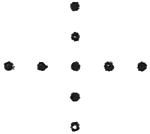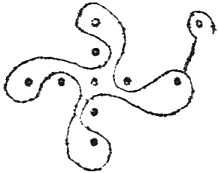
Ancient Mysteries no. 18, January 1981 (continuation of Journal of Geomancy)
{3}
Although not primarily concerning ley-lines, I think that the following might suggest possible ideas that can be gleaned from ‘the lay of the land’.
My study began through my attempts to elucidate the puzzle of what has become popularly known as the Swastika Stone, a unique carving amongst the cup-and-ring stones found in some abundance on Ilkley Moor and its locality in my native Yorkshire. Its name is misleading to anyone not having seen the stone as the symbol is not a swastika, but is reminiscent of one given by James Churchward which is formed of crossed curved strokes forming in his interpretation the sound ‘SH’ or ‘SHEE’. I believe that this sound might well be the sound of this particular sign, connecting as it does with the names Sheba and Seva, and with Glen Shee in Scotland and Mount Sehy in County Cork. Within this ‘swastika’ sign are cup-markings in n the form of a cross, each arm having five cups, thus:

The arm of the cross pointing towards the north is oriented directly at a well-known crag or hill-top above Bolton Abbey known as Simon’s Seat, with its adjoining twin-peak called Earl’s Seat.
The first question I asked was ‘who was Simon?’ and this led me to Rendel Harris’s deductions that Sim-on was a variant of Sem-An, the SEM priest or High Priest of the Great Father God of the Egyptians. Thus I became aware that the symbol on this stone may have been a form of prayer-wheel for the travellers of that time who passed by that place in great numbers as it was then a well-worn highway along the edge of Rumbald’s Moor (or could it have been Rumbler’s Moor?) between the east coast of Britain and the Isle of Man and thence to Ireland. The Egyptians were only one part of the Mediterranean peoples who were travelling in Phoenician ships to all the lands of the far west in search of tin, copper, gold and other metals, and were bringing with them not only a new culture and way of life by the import of grains and cereal-growing, but also brought their own religion.
An agricultural people might be expected to worship the Creator or Supplier of the life-giving food provided through the benificent and multiplying grains, and his son or High Priest was looked upon as the Corn Spirit or god who was called upon to bless the land and the ploughing, and to grant his people an abundant harvest. It is as such a god that TAS is found, his likeness on their coins being often accompanied by grains or ears of corn. So that through all the countries where these people spread there is a connecting link, for they came with peaceful intent, having a great reverence for the One True God personated by the Priest-King, epitomized in the Sun, and symbolized by the sun-cross, whose mediator was the provider of food and the originator of the plough – His Son, the SEM-Priest, known as Tas, Tascio, or Taxi etc.
He was known in Mesopotamia around 2400 BC as Me-Ki-Gal, and in Egypt as Resep-Mikal, and thus was the precursor of the Christian Michael, Archangel and ‘Taxiarch of Heaven’ in name, function and representation.
Tas was the first-born son of King Tur of the Sumerians, founder of the first Aryan dynasty, according to L.A. Waddell in his British Edda; and King Tuur, or Thor, can be equated with Father IA, Bel, or Jove, or Indra, the hurler of the four-angled rain-producing bolt (Rig Veda). FIVE is the number of vowels sacred {4} to the name of the father-god Ia, and also the number associated with Tascio. If placed as :·:, it signifies ‘INDRA’ the father-god of the eastern Aryans, and the worship of Andrew (the same name) with his diagonal cross was widespread in Britain long before Christian times.
The sanctity of hundreds of Holy Hills dedicated to the worship of the Corn-God or the Sem-Priest of the Great Father, has been lost during the intervening centuries through warfare and disturbance by incoming peoples, whereas the hills still known and revered are those which have been Christianized and re-dedicated to the Archangel Michael. Many have been crowned by religious buildings, churches or towers – a legacy no doubt of the original poles, standing stones or circles. The leys that link these mean that these ‘lines of power’ could have originated from knowledge brought by the Aryan Priest-Kings and which was once known in Atlantis. They were certainly preserved into comparatively recent times by the High Priests of the Sun Cult.
I realize that I have greatly simplified what is an extremely complex story with much confusion of names, but this possible idea does seem to make a bit of sense and helps me to convert the ‘cultures’ of the archaeologists into real people who existed and travelled the world as it was before our Christian Era. I had recent proof of the validity of TAS as the god who was worshipped when I found in a number of Cornish churches recently a copy of the Lord’s Prayer hung on the wall, and written in the Cornish language, which begins:
“Agan TAS-ny, us un nef (Heaven) … etc.
I should just add that I also found that where a church is dedicated to St Michael, there is often one dedicated to St Andrew in the vicinity. Many, but not all, are on hills, and most can be found to be on ley-lines. Many Michael churches are linked, especially round here in Somerset. Around the Swastika Stone in the Yorkshire Dales I have found five Michael churches and five Andrew churches within a few miles of it, and Simon’s Seat is undoubtedly on some ley-lines. A job for some Yorkshire-based folk to investigate?
